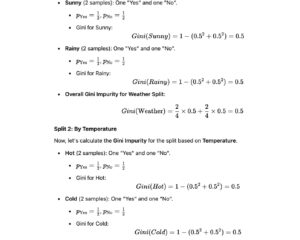Back to: Machine Learning
0
Top-Down Approach in Decision Trees
The Top-Down Approach is the foundation of how decision trees are built, where the tree starts from the root and grows by splitting data into smaller subsets based on the best features.
1. Start with the Root Node:
- Begin with the entire dataset at the root node. This node represents the whole dataset.
2. Select the Best Feature:
- Evaluate all the available features using splitting criteria like Gini Index or Information Gain to identify which feature best separates the data. This selected feature becomes the decision node.
3. Split the Data:
- Based on the selected feature’s values, divide the dataset into smaller subsets. Each subset is represented by a branch in the decision tree.
4. Repeat for Each Subset:
- For each subset:
- Repeat steps 2 and 3 to continue splitting the data.
- If the subset is homogeneous (i.e., all instances belong to the same class), create a leaf node and assign the class label.
- If stopping criteria (e.g., maximum depth, minimum number of samples in a leaf, or no further improvement) is met, create a leaf node with the majority class label.
5. Continue Until Complete:
- Keep repeating this process until all subsets are either homogeneous or meet the stopping criteria, thus completing the decision tree.
Top-Down Approach in Decision Trees: A Step-by-Step Example
Let’s walk through a simple example of the Top-Down Approach to build a decision tree using a minimal dataset. We will calculate Gini Impurity and Information Gain to determine the best feature to split the data.

Step 1: Start with the Root Node
- The root node will represent the entire dataset.
- We need to decide which feature to split the dataset on.
Step 2: Select the Best Feature Using Gini Impurity
Split 1: By Weather
Let’s calculate the Gini Impurity for the split based on Weather.

Overall Gini Impurity for Temperature Split: 0.5
Step 3: Calculate Information Gain
Split 1: By Weather
To calculate Information Gain, we need to first compute the Entropy for the entire dataset and then the entropy for the subsets.
- Entropy for the entire dataset:

Step 4: Repeat for Each Subset
- Based on both Gini Impurity and Information Gain, both features (Weather and Temperature) have the same result (Gini = 0.5, Information Gain = 0), so we can stop further splits and create leaf nodes based on the majority class.
Final Decision Tree:
- The tree would have the root node as either Weather or Temperature (since they both provide the same results), and each leaf node would be labeled Yes or No, depending on the majority class in that subset.
Key Takeaways:
- The decision tree process begins with the root node and evaluates the best features to split the data.
- Gini Impurity and Information Gain help to choose the feature that best separates the data.
- The tree splits the data recursively until it reaches a leaf node with a class label.